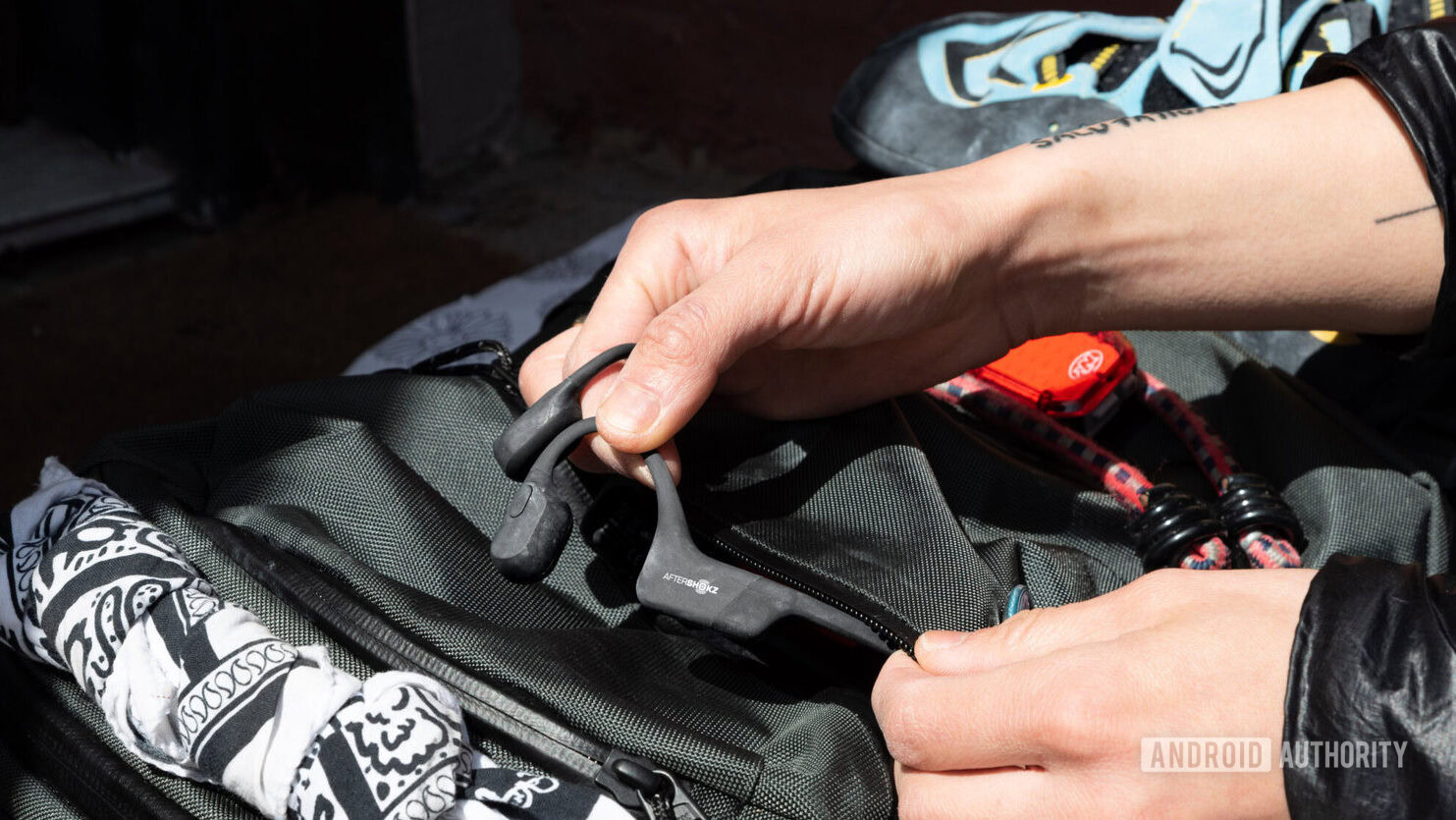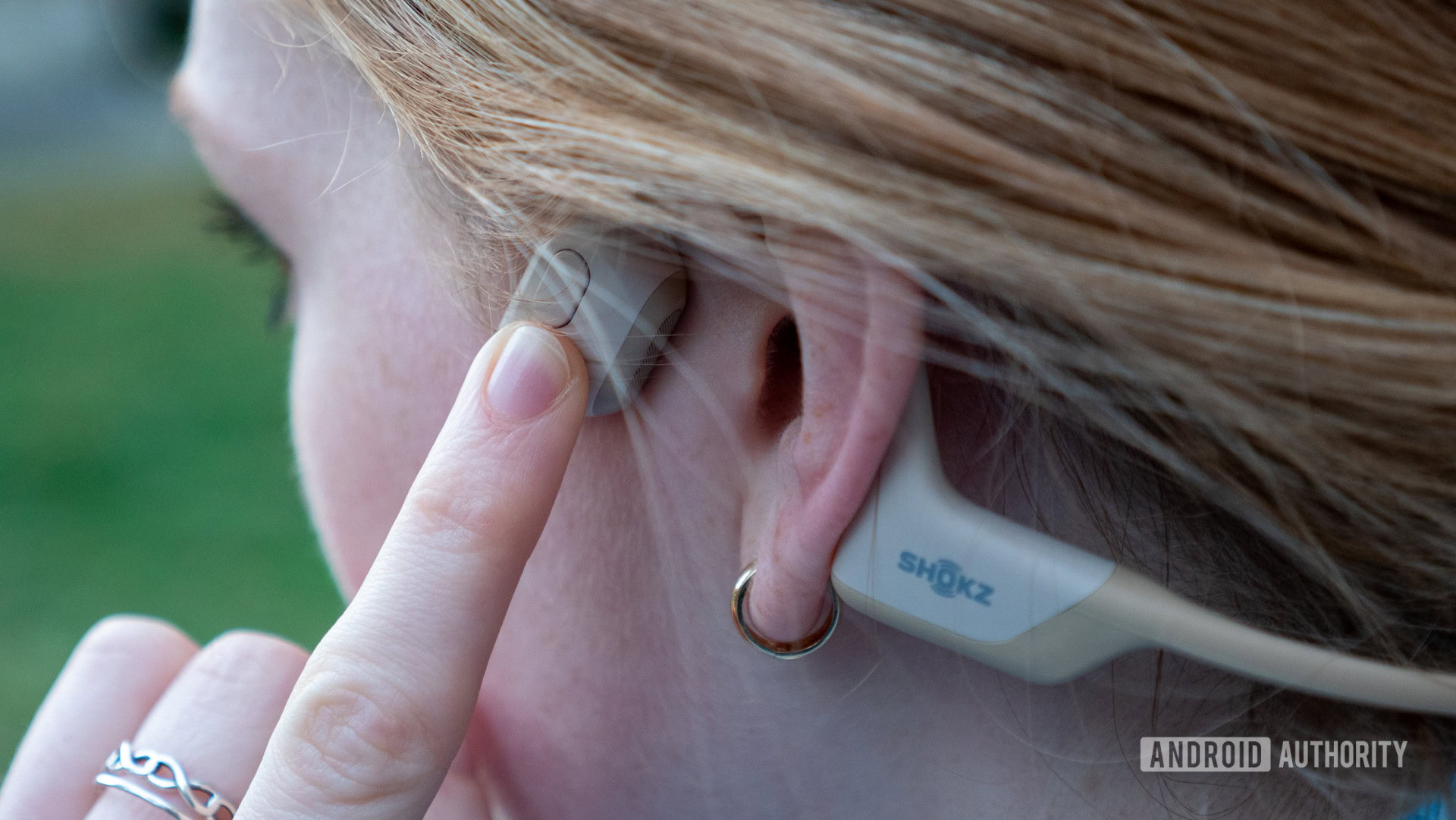Affiliate links on Android Authority may earn us a commission. Learn more.
These are my favorite headphones for rock climbing
Published onJuly 16, 2023

Plenty of earbuds are geared toward running, weightlifting, and even swimming. Despite rock climbing’s meteoric rise and celebrity status, few earbuds and headphones are suitable for the sport. I’ve reviewed hundreds of audio products, and the Shokz OpenRun are the best headphones for rock climbing in my opinion.

Anyone familiar with rock climbing knows that you use a lot of chalk. The chalk absorbs excess moisture from your hands, making it easier to grip holds. As you can imagine, chalk doesn’t just stay on your hands. It gets everywhere.
The Shokz OpenRun are a rebranded version of the AfterShokz Aeropex ($99 at Amazon), and both headphones have a dust-tight construction backed up by their IP67 rating. This reassures me that I can reposition the headphones without worrying about chalk damaging the internals. The same applies to using the onboard button controls. There aren’t any cracks or crevices for debris to slip between the buttons and into the headset. I can switch tracks until I exhaust an entire playlist, painting the buttons in chalk without care.
I can chalk up my hands and use the OpenRun's controls. Doing the same thing with something like the AirPods would risk damaging them.
The OpenRun are also water-resistant. Admittedly, this is less relevant to climbing, but it’s good to know they’re safe from my sweat. Plus, I could theoretically put the OpenRun underwater to clean the chalk off without damaging them. I don’t recommend doing that, but it’s an option in a pinch.
Another handy feature is the titanium headband that can flex in any direction. This design makes it easy to contort the headphones into their pouch and toss them into a gym bag. Plus, the durable build means they should be safe from minor falls and fumbles.
I also appreciate how bone conduction headphones at large leave my ears open to the world. With the OpenRun, I can hear everything around me at the gym. This is particularly important when climbing because I need to hear if someone is beneath me before making a risky move that could result in a fall. Likewise, I like being able to listen to music and remain alert if someone falls nearby.
Stepping beyond climbing for a moment, these open ear headphones are also the safest option for cycling. I usually bike to my local gym, and complete awareness while biking is necessary. Coincidentally, the fit also makes these headphones compatible with certain hearing aids.

That said, the design that allows me to remain situationally aware is also responsible for sub-par audio quality. Don’t get me wrong, the OpenRun sound good for bone conduction headphones, but they don’t actually sound that good. Instead of sitting in your ear canals, bone conduction headphones rest on your cheekbones. They bypass your middle ear, sending vibrations through your skull to your cochlea. As a result, the sound quality lacks bass and clarity.
Another minor irritation is how the sound changes as I chew or drink. The jaw movement from these actions displaces the headphones. I’ve also nudged the headband out of place with my shoulder (imagine twisting your neck 90 degrees to the left and looking up), dislodging the OpenRun mid-climb. As you can imagine, all of this is pretty distracting.
Motions like chewing can displace the headset and temporarily alter the sound quality.
For those who like the idea of bone conduction headphones but are scared off by the sound quality changes, get the OpenRun Pro ($179 at Amazon). These use newer technology, so jaw movement doesn’t affect their sound as intensely. However, while the OpenRun Pro sound great, the OpenRun are a much better value for most people and, funnily enough, are more durable than the pricier Pros.
What other headphones are good for rock climbing?

Any of Shokz’ headphones will be good for rock climbing as they all resist dust and water to varying degrees. However, if you specifically want climbing earbuds, two come to mind.
When reviewing the Jabra Elite 4 and OnePlus Buds Pro 2, these earbuds jumped out at me for their IP55 dust- and water-resistant builds. Both sets of controls work with chalky hands but they operate differently. With the Elite 4, you need to press the button on either earbud to skip songs or answer calls. To do the same on the Buds Pro 2, you must squeeze either earbud stem.
The more traditional earbud experience from Jabra and OnePlus’ buds offers better sound quality than bone conduction headsets too. Furthermore, with OnePlus and Jabra’s earbuds, I don’t have to worry about tilting my head a certain way and pushing the buds out of place. Instead, I can move freely and chew to my heart’s content without compromising the sound quality. Sweat doesn’t pose an issue with fit either: I’ve gone on hour-long runs with both sets of buds, and they’ve never slipped out.
Although these buds seal your ears, they support mono-listening and transparency modes for environmental awareness. These are great accessibility and safety features, but I enjoy stereo playback from Shokz’ headphones. Plus, neither transparency mode can compete with naturally hearing the world through both ears.


Fast charging
Tuned for bass fans
Ultimately, any of these three audio products can endure chalked-up hands, but only the OpenRun have a guaranteed dust-tight build.